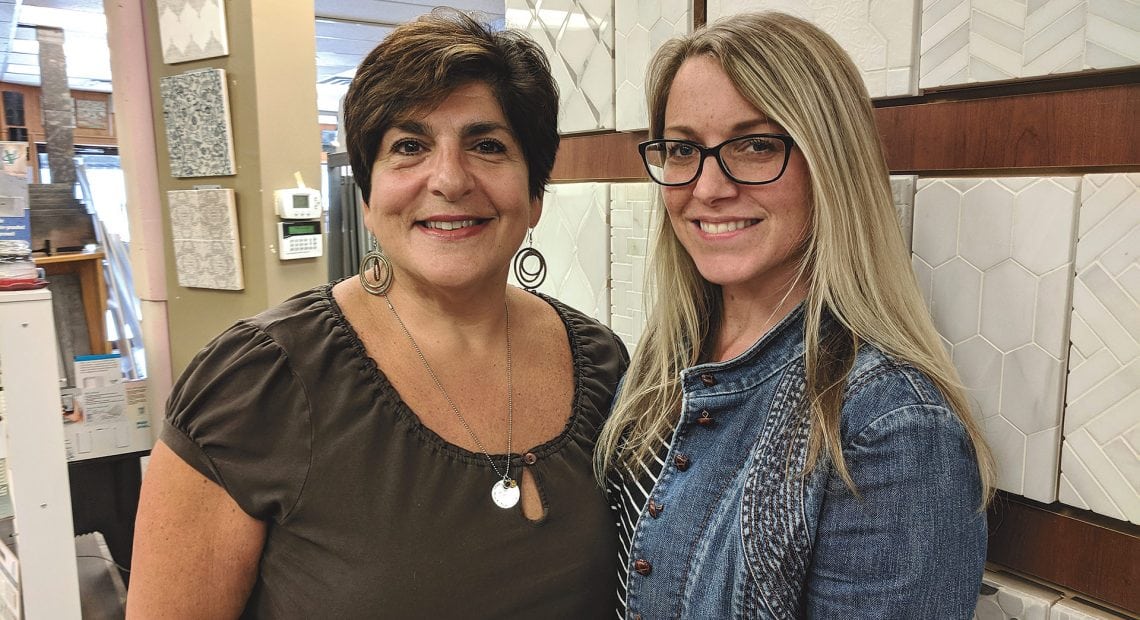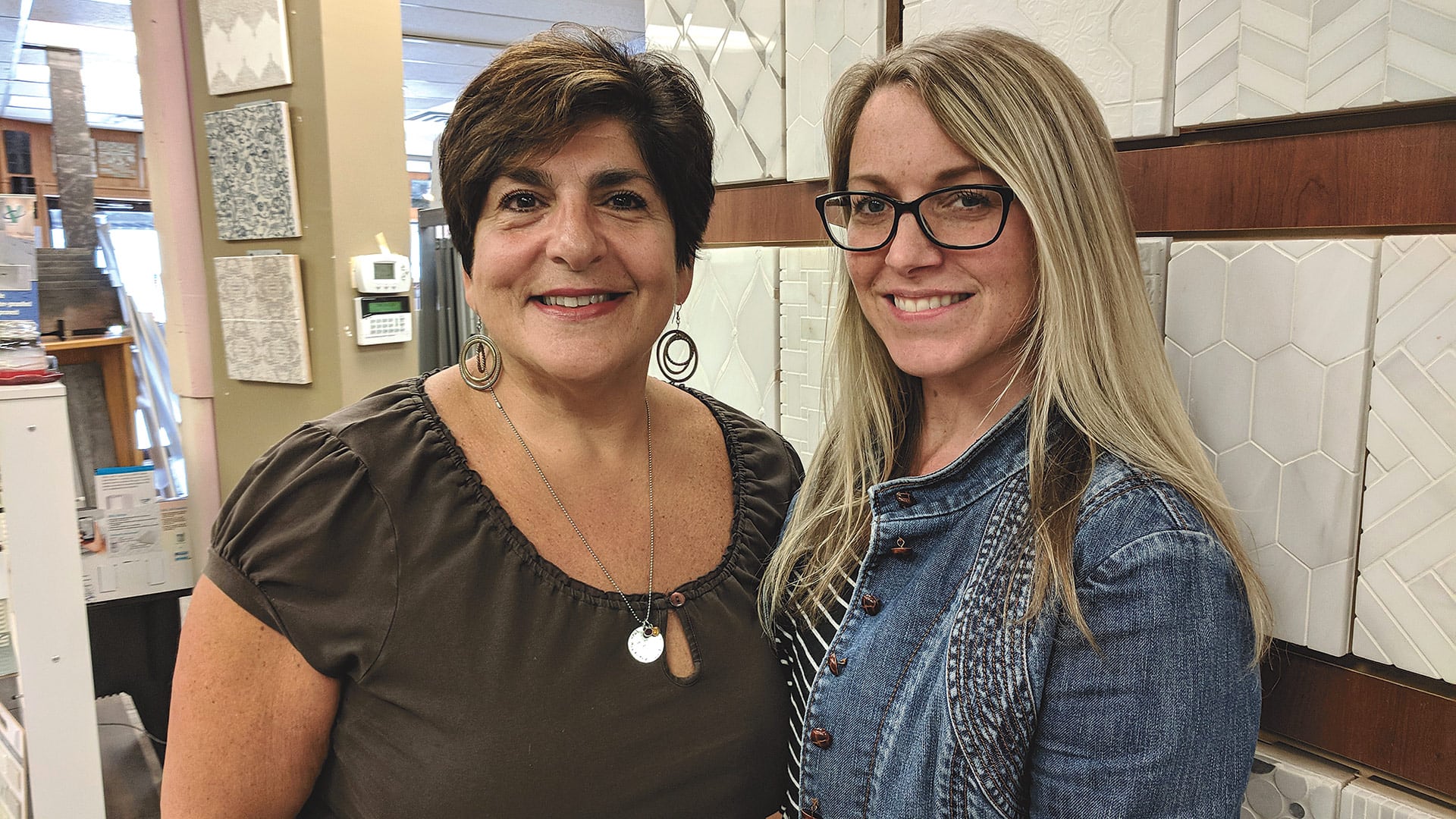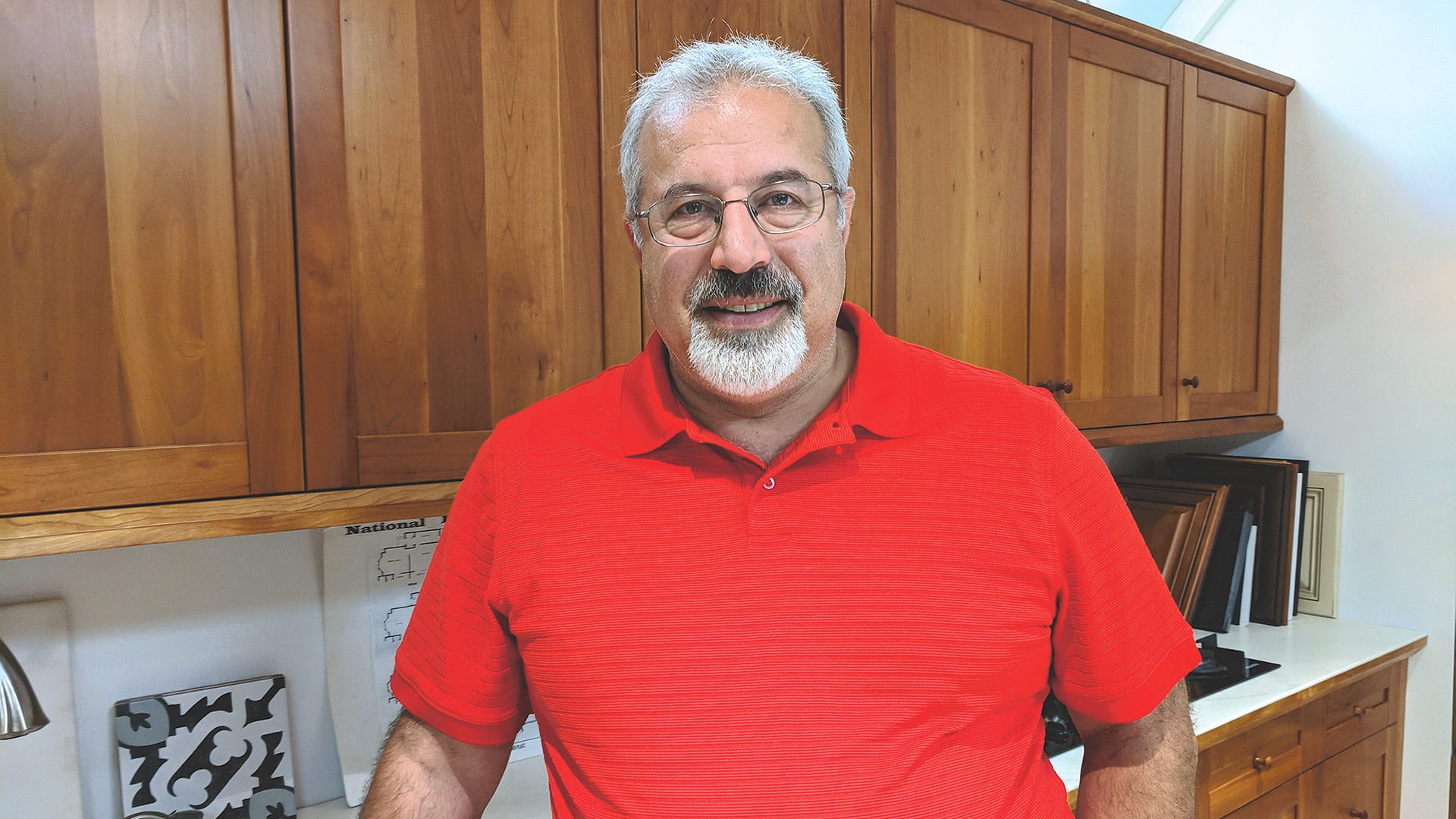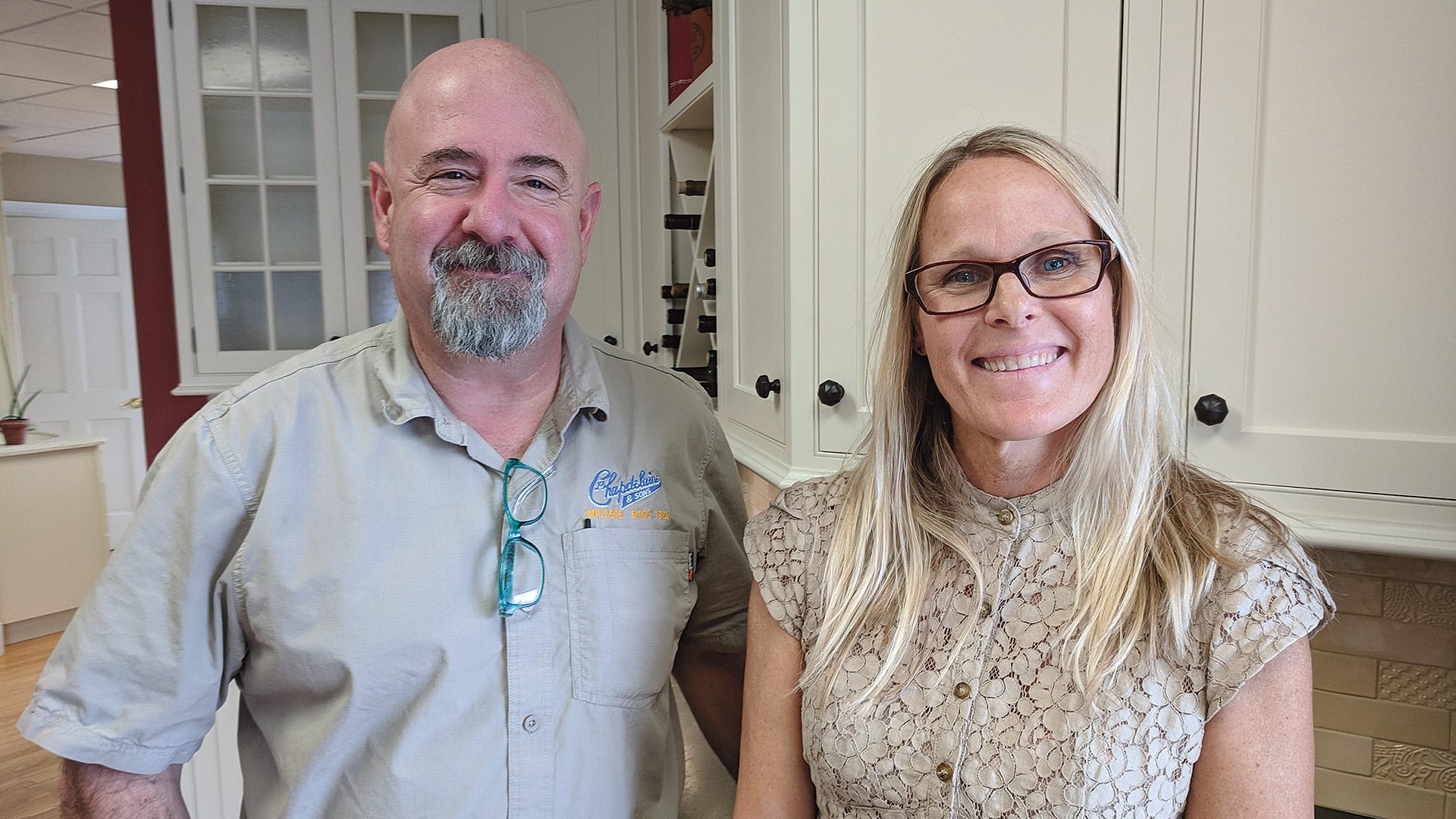
Today’s Kitchens Eschew Color, but Trends Are Always Evolving
Serving Up Style

Karen Belezarian-Tesini (left) and Sarah Rietberg are selling plenty of white and gray tiles these days.
Professional designers can often walk into a house and tell what decade it was built in by the styles of certain rooms, and the kitchen is definitely high on that list. From the high-gloss look of the ’80s to the more neutral ’90s; from a shift back to color at the turn of the Millennium to the current embrace of whites and grays, kitchens do seem to reflect their time. But one trend of the past generation isn’t likely to change — the increased perception of the kitchen as a home’s main hub of activity.
The economy wasn’t the only thing that went flat a decade ago. So did kitchen colors.
“When the economy tanked in 2007, 2008, everything became very flat. Color was gone, along with texture, pattern, flowers. Everything became industrial and cold — no frills. And that’s how the economy was, too,” said Karen Belezarian-Tesini, manager of Best Tile in Springfield. And she’s not the only one who noticed the coinciding trends.
“It’s funny how the economy dictates the colors,” said Frank Nataloni, co-owner of Kitchens & Baths by Curio in Springfield, recalling how many kitchens of the late ’80s featured high-gloss surfaces and plenty of black and red, but when the recession of the early ’90s hit, it was all earth tones. By 2000, color had come back, but around 2008, neutrals took over again. “I don’t know what that means, but when you look back, you can clearly see it.” That decade-ago shift has stuck, however, and even intensified, he added. “Everything now is white and gray.”
While taupe is making a comeback, said Belezarian-Tesini — “I love that more than gray because it gives you an option to go either way, warm or cool” — she’s seen the white-and-gray trend intensify over the years. But better financial times might be causing a subtle style shift.
“Now that the economy is picking back up, it’s getting a little warmer — softer edges, a little more color in glass mosaic or patterns,” she said.
That would be just fine by Lisa Lindgren, designer with Kitchens by Chapdelaine in East Longmeadow.
“The most popular kitchen is white — white on white. So whenever I get a client who wants some color and wants to do something a little different, I get excited,” she told BusinessWest. “People tend to be so scared of color. A lot of it is about sellability, but we tend to encourage people to go for what you like. It’s your house.”

Frank Nataloni says styles shifted away from bold colors when the economy tanked, and have largely remained muted since.
R.J. Chapdelaine, owner of the company, an offshoot of builder and remodeling firm Joseph Chapdelaine & Sons, agreed.
“Whenever you have someone who comes in with a little imagination, wants to have a little fun, it gets exciting,” he said. “And why not? That’s where people want to spend their time. Kitchens are getting bigger, and other living spaces are getting a little bit smaller.”
For this issue’s focus on home improvement, BusinessWest visited a few companies that deal in kitchen design to get a read on some of the hot styles — only to find that the hottest is a decidedly cool white. But they offered plenty of other food for thought as well.
What’s Your Style?
Take countertops, for instance, where white- and gray-colored quartz surfaces are in, both Lindgren and Nataloni said.
But they’ll find contrast in other places, Lindgren noted, like weathered driftwood for accent pieces or a dark wood floor — or, more commonly these days, porcelain planks designed to look exactly like wood. “That’s the most popular floor. You can’t even tell it’s not wood. It’s pretty fascinating.”
“That seems to be what everyone’s looking for right now,” Nataloni added. “With some of them, it’s amazing how much it actually looks like real wood. You can even feel the texture. That’s what people are looking for.”
And homeowners aren’t stopping in the kitchen, Belezarian-Tesini said. “When I sell those planks, I might sell 2,000-3,000 square feet at a time. They’re doing their bedrooms, they’re doing the whole house. It’s just incredible. People say, ‘oh my gosh, I love that,’ and when we tell them that it’s porcelain, they look again and say, ‘are you sure? Really?’ ‘Yeah, really.’”
In addition to the move away from tile floors into wood and wood-like porcelain, Chapdelaine noted that shiplap walls — in both vertical and horizontal patterns — are popular as well, perhaps driven by their ubiquitousness on HGTV.
As for cabinetry, while painted white tops the list right now, Nataloni said, he was working with someone recently who wants a black cabinet with a rubbed-off type of finish so there’s some wood coming through. Still, those neutral shades provide plenty of flexibility.

R.J. Chapdelaine and Lisa Lindgren say it’s fun to work with customers who have a design vision not necessarily bound by what’s currently fashionable.
“With a white or gray cabinet, we can make it look very formal or casual in the scheme of things,” he said. “I haven’t sold a cherry kitchen in over a year, but at one time, that was probably 60% of our business. Some woods remain relatively popular, though, including walnut. “That’s the fashion part of the business, and it changes depending on who walks through the door.”
Sarah Rietberg, showroom manager at Best Tile, said all these trends amount to people seeking a clean, uncluttered look in their kitchens, which is why subway-style tile backsplashes are still common, but with a twist — different sizes, something with a little texture to it, or even lines that aren’t perfectly straight.
“Those things can add some oomph to subway tile,” she said. “People want a little movement, but nothing too crazy. They don’t want to take away from the other things going on.”
In addition, a well-placed accent color can be striking amid a sea of white, Chapdelaine said. “We just did one all-white kitchen with a hale navy blue island, and it’s a striking look.”
Indeed, Belezarian-Tesini said, many customers complement the dominance of white and gray with mosaic tile backsplashes; where once a mosaic pattern broke up the solid color of the rest of the backsplash, now it’s being used across the entire backsplash to break up the white of the kitchen.
Sometimes it’s hard to predict the next trend, she added. “If you asked me 10 years ago if glass would still be here, I’d have said no, but glass is hotter than it’s ever been. It’s the medium of choice now. People still use ceramic, and porcelain has really come up the ladder. But glass has become the decorative. It’s a 10-year trend for sure, and it’s probably going to last longer than that.”
Meanwhile, she sees metallic tile coming into its own. “As technology gets better, you’re going to see more things within the glazing. You’re even seeing crystals in the glazing, little pieces of metal, to create a true, realistic metallic. So technology advances, and the tile changes.”
Good, Better, Best
The upside of so many options in kitchen surfaces is that there’s typically something for every budget, Nataloni said.
“We have to have a good, better, and best product selection,” he told BusinessWest. “We have a product for people flipping homes that’s very current with the trends, reasonably priced, good quality, with a quick turnaround time. Then we have a semi-custom type of product that offers a lot of selection and is a little quicker than the higher-end product. That means a lot if someone is doing a home renovation, because a kitchen is not an inexpensive proposition. If you know where to save money, you can get more bang for your buck, and that’s our skill.”
Some customers arrived with a vision in mind for their kitchen, he explained, and his job is to refine it. “Then there are other people who come in and don’t have a vision, and they’re looking for me to help them create the vision. That’s why we have to be flexible in meeting the need of whoever is coming to us.”
To help people envision the end product — quite literally — Nataloni uses a virtual-reality device called ProKitchen Oculus, which uses Oculus VR goggles to allow people to walk around in the environment Nataloni has programmed into the computer.
“For people who have a hard time visualizing, it really solves that problem for them,” he said. “We create a basic floor plan in 3D, and you’re actually in the room, so you can look and walk around. They literally see what they’re going to buy, or as close as possible to what it’s going to be like.”
For example, one customer was having trouble envisioning the soffit Nataloni suggested for the top of their cabinets. “Then I showed it to them on the Oculus, and their response was, ‘oh, now I understand what you were talking about.’ For those type of people, it really helps tremendously.”
Chapdelaine also sees a healthy mix — about 50-50 — of people who know exactly what they want and customers who need a little more guidance. “And that guidance can occur through Lisa, or through decorators. We see clients occasionally bring in a decorator to help them make decisions on color, cabinetry, and tile.
Most of those are typically renovating their whole house, Lindgren added. “It doesn’t tend to happen just with a kitchen, but with a broader scope.”
Whole-home renovations are common these days, said Chapdelaine, who noted that the remodeling business has been outpacing new home building for some time. His grandfather, who first hung out a shingle in 1925, saw the value of remodeling work early on, and evolved the firm in that direction after originally focusing on new construction.
“That became an integral part of our business,” he said. “You have to evolve. I see people who just build houses or just remodel, and I’d find that difficult. You can go from building three, four, five houses at a time to building one or maybe none, and doing all remodeling.”
Open Wide
He and Chapdelaine’s father also recognized perhaps the most prominent shift in kitchen design, and one that remains dominant today — the open floor plan.
“They were building compartmentalized houses, but they rolled into a more open floor plan on the single-story executive ranches,” he recalled. “Now, there’s very little compartmentalized building. Everything is wide open, with less formal living spaces.”
Nataloni said homeowners prefer a free flow of traffic through the kitchen, and islands are desirable if they can be put in. “Gone are the days of the U-shaped kitchen or a peninsula only, unless it’s necessary. Everyone is looking to have cabinetry that creates the outside shell of the kitchen and then some kind of an island in the middle, whether it’s with seating or without.”
That’s also the style potential homebuyers prefer when they’re visiting open houses, which is one reason why hot trends — like that white and gray — remain so dominant once they take hold; people design the room not only for their own comfort, but with resale in mind.
“For many people, this is where they’re staying, but we do have a lot of people coming in saying, ‘look, I want to fix up the kitchen, and we’re not going to be here forever, so I want it saleable,’” he noted. “We get probably more of the people who are staying for the foreseeable future, and they want to enjoy it. That’s the majority of our business.
Belezarian-Tesini said most of her business at Best Tile contractor-driven — either builders putting up or remodeling houses, or homeowners shopping for product, then hiring a professional to do the work. The do-it-yourself crowd is much smaller — perhaps because the kitchen is such a critical part of 21st-century home life that people don’t want to get it wrong.
That said, “business has been fantastic,” she noted. “I’ve seen a lot of new construction over the last few years. When I started here 23 years ago, it was all new building. Then it went to remodeling, and now it’s coming back again to new construction, which is nice to see.”
So, for the foreseeable future, she’ll continue to track the design trends and help customers design the kitchen of their dreams — usually with an open concept.
“It makes for easy living, and really great entertaining,” she said. “After all, the kitchen is the heart of the home.”
Joseph Bednar can be reached at [email protected]




